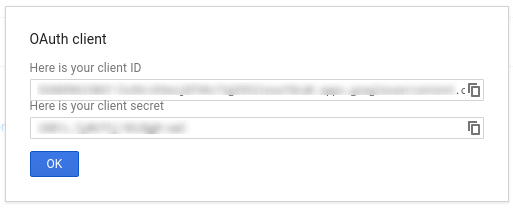所有 Google Ad Manager API 调用都必须通过 OAuth2 授权。OAuth2 是一种开放式标准, 让用户能够向第三方应用授予权限,因此 应用可以代表用户与网络服务进行交互。OAuth2 可启用 通过您的 Ad Manager API 客户端应用访问用户的 Ad Manager 账号 而无需处理或存储用户的用户名或密码。
生成 OAuth2 凭据
如需生成 OAuth2 凭据,请执行以下步骤。
1. 确定身份验证类型
请查看下表,了解最适合的身份验证类型 Ad Manager API 应用:
| 选择您的 OAuth2 身份验证类型 | |
|---|---|
| 服务账号 |
如果您只需访问自己的 Ad Manager 数据,请选择此选项。 了解详情。 |
| Web 应用 |
如果您想以任何授予 向您的应用授予访问其 Ad Manager 数据的权限。 了解详情。 |
2. 创建 OAuth2 凭据
确定身份验证类型后,请点击相应的标签页 并按照说明生成 OAuth2 凭据:
<ph type="x-smartling-placeholder">- 打开 Google API 控制台的“凭据”页面。
- 从项目下拉菜单中,选择创建新项目,然后输入名称 (可选)修改所提供的项目 ID。点击 创建。
- 在“凭据”页面上,选择创建凭据,然后 选择服务账号密钥。
- 选择新的服务账号,然后选择 JSON。
- 点击创建以下载包含私钥的文件。
- 打开 Google API 控制台的“凭据”页面。
- 从项目下拉菜单中,选择创建新项目,然后输入名称 (并根据需要修改提供的项目 ID),然后点击 创建。
- 在“凭据”页面上,选择创建凭据,然后 选择 OAuth 客户端 ID。
- 系统可能会提示您在 同意屏幕页面;如果有,请点击配置同意屏幕。 提供所需信息,然后点击保存以返回 “凭据”页面。
- 选择 Web 应用作为应用类型。按照 指令以输入 JavaScript 来源和/或重定向 URI。
- 点击创建。
- 在随即显示的页面上,复制客户端 ID 和客户端密钥 复制到剪贴板,因为在配置客户端时将会用到 库。

3. 配置您的 Ad Manager 广告资源网
如果您是第三方开发者,则可能需要让您的客户执行此操作 这一步。
<ph type="x-smartling-placeholder">- 前往您的 Ad Manager 广告资源网。
- 点击管理标签。
- 确保已启用 API 访问权限。
- 点击添加服务账号用户按钮。
- 在表单中填写服务账号电子邮件地址。通过 必须为服务账号用户授予 实体就像该服务账号用户将访问该网站上的实体一样 界面
- 点击保存按钮。此时应显示一条消息, 以及添加服务账号
- 查看现有的服务账号用户,方法是转到“用户”标签页,然后 点击服务账号过滤条件。
- 前往您的 Ad Manager 广告资源网。
- 点击管理标签。
- 确保已启用 API 访问权限。
4. 配置和使用客户端库
请按照下面的相应指南在您的客户端库中使用凭据:
Java
.NET
Python
PHP
Ruby
如果您选择不使用我们的任何客户端库,则需要使用 OAuth2 服务账号或网络 应用流程。
幕后花絮
我们的客户端库会自动处理下述细节 如果你对幕后花絮感兴趣,请继续阅读。 本部分面向已熟悉 符合 OAuth2 规范并 了解如何结合使用 OAuth2 和 Google API。
HTTP 请求标头
向 Ad Manager API 发送的每个请求中的 HTTP 标头都必须包含访问权限 以下形式的令牌:
Authorization: Bearer ACCESS_TOKEN
例如:
POST … HTTP/1.1 Host: … Authorization: Bearer 1/fFAGRNJru1FTz70BzhT3Zg Content-Type: text/xml;charset=UTF-8 Content-Length: … <?xml version="1.0"?> <soap:Envelope xmlns:soap="http://www.w3.org/2001/12/soap-envelope"> … </soap:Envelope>
范围
一个访问令牌可授予对多个 API 的不同级别的访问权限。答
名为 scope 的变量参数用于控制资源集和
访问令牌允许的操作。在请求访问令牌期间,您的
应用在 scope 参数中发送一个或多个值。
Ad Manager 只有一个范围(如下所示)。应执行授权 在产品内的用户级别设置
| 范围 | 权限 |
|---|---|
https://www.googleapis.com/auth/dfp |
在 Ad Manager 上查看和管理您的广告系列。 |

